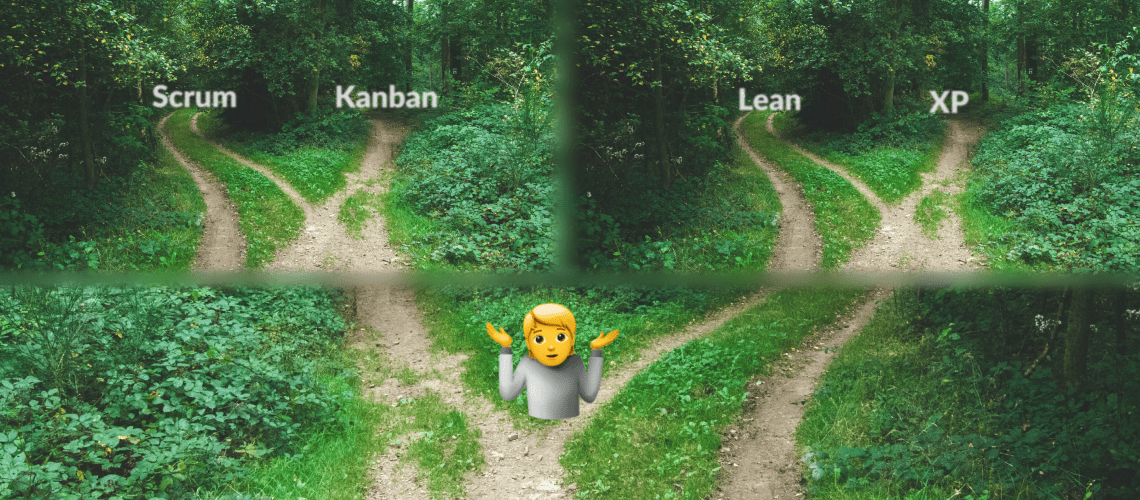Agile and Scrum methodologies are designed to promote flexibility, collaboration, and iterative development, and can be particularly effective in complex and rapidly changing environments. Scrum, in particular, has become one of the most widely adopted agile frameworks, and many teams rely on its structured approach to project management and sprint-based delivery. However, there are many other agile and Scrum methodologies, each with their own unique principles and practices.
In this blog post, I provide an overview of some of the most commonly used Agile and Scrum methodologies, including Scrum, Kanban, Extreme Porgramming (XP), and Lean, and show you how to choose and implement the best approach for your team or organization. Whether you're new to Agile or you're looking to explore alternative methodologies and frameworks, I hope this post provides valuable insight and inspiration.
The role of Agile Coaches in the implementation of agile and Scrum methodologies
While the role of Agile Coaches can vary depending on the size and complexity of the organization, the focus is on helping teams and stakeholders adopt and optimize Agile and Scrum methodologies and help them achieve greater success and satisfaction in their work. Whether you work with an internal Agile Coach, hire an external consultant, or are an Agile Coach yourself, it is important to have a clear understanding of the role and responsibilities and work together to achieve Agile goals.
The top 10 most used agile and scrum methodologies
- Scrum: A popular agile framework widely used in software development. Scrum is a lightweight, iterative framework that emphasizes collaboration and adaptive planning.
- Kanban: An agile methodology that focuses on visualizing and limiting work in progress. Kanban emphasizes continuous delivery and flow.
- Lean: A methodology based on the principles of the Toyota Production System. Lean focuses on delivering value to the customer and eliminating waste.
- Extreme Programming (XP): A methodology that emphasizes the values of communication, simplicity, feedback, and courage.
- Crystal: A family of Agile methodologies tailored to specific project characteristics such as team size, criticality, and complexity.
- Feature-Driven Development (FDD): An agile methodology that focuses on feature delivery and prioritization based on business value.
- Agile Data: An agile methodology developed specifically for data-intensive projects such as data warehousing and business intelligence.
- Dynamic Systems Development Method (DSDM): An agile methodology that emphasizes rapid deployment, active user involvement, and flexible planning.
- Scaled Agile Framework (SAFe): A framework designed for large, complex projects and organizations. SAFe provides a structured approach to scaling Agile.
- LeSS (Large-Scale Scrum): LeSS is a methodology developed for large Scrum projects with multiple teams, providing a framework for coordinating and aligning multiple Scrum teams.
It should be noted that this list is not exhaustive and that there are other methods and frameworks that are also widely used in agile development.
Most Agile Coaches and Scrum Masters run in circles...
...fixing superficial symptoms. Time to use psychology to foster sustainable mindset change.
Why adopt Agile in the first place?
Agile and Scrum methodologies have become increasingly popular in recent years, and for good reason. Adopting an Agile approach has been proven to improve project success rates, shorten time-to-market, and increase customer satisfaction. For a more detailed overview and more data on the positive impact of Agile, check out our recent article: 23 Agile statistics for 2023.
In addition to these benefits, adopting an agile methodology can also lead to improved team morale and satisfaction by empowering team members to take responsibility for their work and collaborate more effectively. In fact, studies have shown that teams that adopt agile methodologies have higher job satisfaction and are more likely to meet project deadlines and goals. At this point, once again the reference to our article on this: 23 Agile statistics for 2023.
However, it is important to know that agile and Scrum methodologies are neither a panacea nor a one-size-fits-all solution. Depending on the particular circumstances of your team, it may be necessary to modify or combine different frameworks to achieve the best results. Nonetheless, there may be challenges with implementation, such as resistance to change, lack of understanding, and difficulty measuring success. Especially in larger organizations with more complex workflows and established hierarchies, such obstacles are more common.
In addition, it can be difficult for teams to fully embrace the agile mindset, which emphasizes adaptability and flexibility over rigid processes and procedures. Further, it is important to recognize that what works for one team or organization may not be appropriate for another.
But don't let that put you off: Agile and Scrum methodologies are not without their difficulties, but the benefits of an agile approach are clear. By focusing on collaboration, flexibility, and continuous improvement, teams can achieve better results and deliver high-quality products in less time. So if you're looking for a way to increase your team's productivity and improve your chances of project success, consider adopting an agile methodology today.
6 simple steps to implement a (new) agile or scrum methodology
- Evaluate the current state: The first step is to assess the current state of the organization and determine if an agile or scrum methodology would be beneficial. This can be done by assessing the organization's goals, processes, culture, and level of adoption of agile ways of working.
- Research and choose the appropriate framework: Once you have decided to implement an agile or scrum methodology, you should research and select the most appropriate framework for your organization's needs. Consider factors such as team size, project complexity, and company culture.
- Plan the implementation: Develop a plan and prepare for implementation of the new agile or scrum methodology. This includes defining roles and responsibilities, providing training and resources for team members, and establishing clear communication channels.
- Pilot the methodology: Begin testing the new agile or Scrum methodology on a small project or team to test effectiveness and identify areas for improvement.
- Monitor and evaluate: Monitor the progress of the pilot and evaluate the effectiveness of the new Agile or Scrum methodology. Gather feedback from team members and stakeholders and use it to make improvements and adjustments as needed.
- Scale and expand: Once the pilot is successful, you should extend the new agile or Scrum methodology to other projects and teams within the organization.
When evaluating the effectiveness of the new agile or Scrum methodology, you should consider factors such as team productivity, quality of deliverables, customer satisfaction, and the overall success of the project. It's also important to monitor changes in team dynamics, communication, and collaboration. Of course, these steps are somewhat abbreviated or simplified; they provide you with a rough guideline. Exactly what these steps look like depends on the circumstances in your organization.
Remember that implementing a new agile or Scrum methodology is not a one-time event. It requires constant effort and continuous improvement to ensure long-term success.
Tips for adapting an agile or Scrum methodology
For small businesses, it is important to focus on simplicity and flexibility. Small businesses typically have fewer resources and employees, so it is important that the agile or Scrum methodology is easy and simple to adopt. It can be helpful to start with a basic agile framework like Scrum and then adapt it as needed to meet the specific needs of the business. It is also important to involve all team members in the process and encourage open communication and collaboration.
Medium-sized companies often have more resources and staff than small companies, but may still face challenges when implementing a new agile or scrum methodology. It can be helpful to appoint a dedicated team or person to oversee the implementation process and ensure that all stakeholders are involved and informed. In addition, it may be beneficial to start with a pilot project to test the agile or Scrum methodology before rolling it out to the entire organization.
For large organizations, implementing a new agile or Scrum methodology can be complex and challenging. It is important to involve all stakeholders, including senior management, project managers and team members, in the process to ensure acceptance and support. It can be helpful to appoint an experienced Agile coach or consultant* to oversee implementation and provide guidance and support. In addition, it is important to set clear goals and metrics to track the success of the implementation and make necessary adjustments.
Regardless of the size of the organization, it is important to approach the adoption of a new Agile or Scrum methodology with an open mind and a willingness to experiment and adapt. It is important to note that the choice of methodology or framework is not always clear-cut and may require experimentation and customization to find the right solution for your team and project. It is also possible to combine elements of different agile methodologies and frameworks to create a hybrid approach that meets the specific needs of your team.
Tips for building acceptance and support
When introducing a new agile and Scrum methodology to a team, it is important that the team members and stakeholders accept and support the new methodology. This can be challenging, especially if the team is not used to working with agile methodologies or frameworks.
For teams already working with agile methods or frameworks, it can be easier to gain acceptance and support. These teams are often more open to change and experimentation. In this case, it's important to highlight the benefits of the new agile or Scrum methodology, such as increased efficiency, better quality, or better communication. You can also involve team members in the decision-making process by asking for feedback and ideas. This can help create a sense of identification with the new agile or Scrum methodology.
For teams that are not yet familiar with agile and Scrum methodologies, it can be more difficult to build acceptance and support. In this case, it is important to first educate team members and stakeholders about Agile and Scrum methodologies. This can include training sessions or workshops to help team members understand the principles and benefits of Agile. It is also important to address any concerns or skepticism team members may have about the new agile or Scrum methodology. You can do this by citing examples of successful Agile implementations in similar organizations or industries. At the same time, concerns or skepticism should be perceived and heard and not ignored or dismissed as null and void.
Regardless of how much experience the team has with agile and Scrum methods, it is important to involve key stakeholders in the decision-making process. This may include managers, product owners, and other members of the organization who may be affected by the new method or framework. By including stakeholders in the decision-making process, you can ensure acceptance and support, and make sure everyone is pulling in the same direction and working toward the same goals.
Finally, it is important to be patient and persistent when building acceptance and support for a new agile or Scrum methodology. Change can be challenging, and it may take some time for team members to fully embrace the new methodology or framework. By consistently communicating the benefits and involving team members and stakeholders in the decision-making process, you can build a solid foundation for success.
Examples and Best Practices
Agile and Scrum methodologies have their own strengths and weaknesses. Understanding these strengths and weaknesses can help organizations choose the best approach for their specific needs. Here are a few best practices for the 4 most common agile frameworks:
Scrum for example, is ideal for teams working on complex projects with changing requirements, such as software development. The emphasis on regular communication and iteration ensures that teams are always working toward the most important goals.
Kanban on the other hand, is better suited for projects with a more predictable flow, such as on the shop floor or assembly line. Its focus is on limiting work in progress and visualizing the status of tasks to improve overall efficiency and productivity.
Extreme Programming (XP) with its focus on software engineering best practices, can be particularly effective for projects with a high degree of technical complexity or when quality is paramount. The emphasis on practices such as test-driven development and continuous integration helps teams produce high-quality software quickly and efficiently.
Lean can be applied to a wide range of industries and projects where the goal is to minimize waste and maximize value. This can include everything from manufacturing to healthcare to software development. Focusing on understanding customer needs and eliminating non-essential steps or processes can help companies deliver products or services that truly meet customer needs.
Summary Agile and Scrum methodologies
In conclusion, adopting Agile and Scrum methodologies can be of great benefit to teams and organizations as it helps them achieve better results and reach their goals more effectively. In this post, we have discussed the benefits of Agile, Scrum framework and other popular agile methodologies.
Finding the right agile or Scrum methodology for your team or organization will most likely require some experimentation and research. However, by considering the factors we've discussed and using the tools and resources available, teams can effectively evaluate and select the best agile or Scrum methodology for their individual needs.
I encourage you to continue your agile journey by experimenting with different agile and Scrum methodologies, seeking out expert content and best practices, and keeping up to date on the latest tools and resources. With a commitment to agile principles and a willingness to learn and adapt, teams can realize the full potential of agile and Scrum methodologies and achieve greater success in their projects and goals.
Have fun experimenting!








